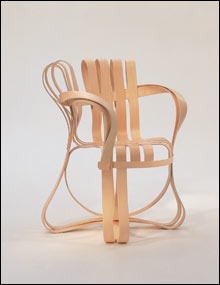
“CROSS CHECK ARM CHAIR” By Frank Gehry, laminated maple, ca. 1992. |
Richard Prince's 2008 "Nurse Hat Chair" sits next to a gothic French "Joined Chair" in the first gallery of the extensive "Sit Down!" — book-ending the six centuries of chairs represented in the exhibit. The sleek polyurethane and stainless steel of Prince's chair is laughable when elbowed with the arduously carved ceremonial oak throne. The worn grain of the 1500s-era seat mocks the sex appeal of Prince's work, rendering it more like a space-age Dumbo. The comparison of these two cultural artifacts lays out the themes explored by the showcase of Bowdoin College Museum of Art's European and American furniture collection, considering the chair a barometer of larger social and economic realities and cultural trends, viewing cultural progression through the lens of an easily overlooked everyday object.The exhibit unfolds for the most part chronologically, opening with severe and ornate examples of late-Gothic chairs, and the "owl eye" splat and cabriole legs of Rococo. This time period marks the beginning of an improving world economy and expanding middle class; a time when style and quality became more accessible to a wider audience and the role of the chair shifted from that of a status object for nobility or authority to household furniture. Pattern books by Thomas Sheraton and Thomas Chippendale, which are also on view in the gallery alongside joiners' tools, distributed designs worldwide and made fashion accessible to many. A highlight here is the stately 17th-century "Great Joined Chair," attributed to William Searle and acquired by Bowdoin in 1872.
The exhibit moves to the neoclassical infatuation with Roman and Greek styles and the reappropriation of the ideals of symmetry, geometry and flat surface ornamentation. A Greek urn serves as supporting material for the mahogany reimaginations of the Greek klismos featured in the exhibit, showing a woman seated in a chair with similarly attenuated legs and a curved back. Paintings and photographs supplement the furniture throughout the show, placing the chairs in larger interior and cultural contexts. A portrait of Thomas Jefferson by Gilbert Stuart seats the president in a neoclassical French bergere; beside it is an 1810 example of a mahogany and horsehair bergere, notably owned by the father of Henry Wadsworth Longfellow.
A Gustav Stickley armchair with its original leather in beautiful condition represents Arts and Crafts as one of a host of styles featured in the gallery dedicated to revival and reform movements. A novelty piece in the show, a library chair designed by Augustus Eliaers with an 1853 patent is displayed to expose its metamorphic capabilities. The chair converts to library steps while maintaining a fashionable Renaissance revival style. Windsor chairs and envelope pushing designs by Joseph Hoffman and Samuel Gragg bolster the 19th-century room.
The 20th-century modern gallery boasts a collection of Bauhaus works, including a "Dining Chair" and a "Long Chair" by Marcel Breuer displayed with a Japanese inspired stool by Charlotte Perriand. A whimsical Robert Venturi "Queen Anne" chair recalls 18th-century Rococo styles in a crimson-painted bent plywood, and requisite pieces by Charles Eames and Eileen Gray exhibit curvilinear and angular extremes. Local architect and furniture designer Christopher Campbell's 2008 "Turtleback Chair" can be found in its two permutations in the museum, as rocking chair and as dining chair, and local sculptor Duane Paluska's elegant deconstructed chairs conclude the show.
 Topics
Topics:
Museum And Gallery
, Henry Wadsworth Longfellow, Thomas Jefferson, Marcel Breuer, More  , Henry Wadsworth Longfellow, Thomas Jefferson, Marcel Breuer, Frank Gehry, Richard Prince, Charles Eames, Christopher Campbell, Bowdoin College Museum of Art, Bowdoin College Museum of Art, Duane Paluska, Less
, Henry Wadsworth Longfellow, Thomas Jefferson, Marcel Breuer, Frank Gehry, Richard Prince, Charles Eames, Christopher Campbell, Bowdoin College Museum of Art, Bowdoin College Museum of Art, Duane Paluska, Less 